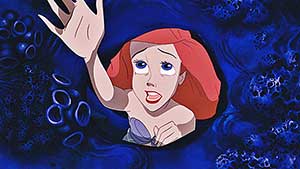Dear Readers,
To celebrate the 25th anniversary of The Little Mermaid, co-writers/co-directors Ron Clements and John Musker spoke at the 2014 Ottawa International Animation Festival about kick-starting the Disney Renaissance. Here are some of the behind-the-scenes tidbits they revealed:
1. The idea for The Little Mermaid was "gonged" when it was first pitched to Disney.
In a classic case of almost-wasn't, Ron Clements' original two-page proposal got shot down by Disney execs Michael Eisner and Jeffery Katzenberg at an animator presentation called "The Gong Show". This was partly a knee-jerk reaction to rumours of a sequel to Splash being in the works. But that wasn't the only reason…
2. Before The Little Mermaid , Disney hadn't made a fairy tale since the 1950s.
Even though most people think of Disney as a fairy tale factory, the company hadn't brought one to the big screen since Sleeping Beauty in 1959. Audience sensibilities were thought to have moved too far away from the coming-of-age classics that focused on women. Or, in other words…
3. Executive Producer Jeffery Katzenberg believed that "girl movies don't make money."
The budget for the film was modest for a big theatrical release because Katzenberg didn't think the film would do any better than Disney's release the previous year, Oliver & Company. Oliver & Who? Oh, how the times have changed (well, not really).
4. The name Ariel was inspired by a character in the Footloose.
Forget Hans Christian Anderson—Clements had Kevin Bacon on the brain (or, more specifically, Lori Singer) when he came up with the name for his Siren. Clements says it wasn't a conscious thing, but now admits that the parallels between a town that prohibited dancing and a women who has to give up her voice no doubt collided in his mind during the creative process.
5. Sebastian was originally going to be British, and named Desmond.
Clements and Musker originally wrote Ariel's crabby sidekick as a stuffed-shirt British servant. Song producer and lyricist Howard Ashman is the one who suggested (insisted, even) that they make the character a Rastafarian Jamaican, which would allow him to bring in some Calypso-themed music. Good move, especially since the film won Ashman and composer Alan Menken an Oscar for "Under the Sea". You can watch that night's cringe-worthy performance here.
6. Ariel was supposed to have a dolphin best friend voiced by Robin Williams.
It only makes sense to have a dolphin in a sea-themed movie, right? Problem was, Clements and Musker had overloaded their script with characters. They also realized that Ariel had been written as too passive—inspired by Laura from The Glass Menagerie. So they decided to cut the dolphin and put that character's agency into Ariel. Then they put Robin Williams in their next film, Aladdin.
7. Jim Carrey auditioned for the role of Prince Eric.
Four years before he became Ace Ventura, Jim Carrey auditioned for the role of Ariel's prince charming. He lost out to 16-year-old Christopher Daniel-Barnes, who everyone thought sounded much older than he actually was. While Jim Carrey went on to become – well, Jim Carrey – Barnes became famous for playing Greg Brady in The Brady Bunch films before parlaying the skills he developed with Disney into a fairly spectacular voice-acting career.
8. Ursula was inspired by Bea Arthur, Joan Collins, and Divine—and Roseanne Barr auditioned for the part.
Different animators brought different aspects to Ursula's personality, but the script specifically referenced Bea Arthur in The Golden Girls. This "unflattering" comparison to a sea-witch apparently turned Arthur (or her agent) off from considering the part. But that didn't matter, because the personality was rounded out as part drag queen, part "matron of Miami"—complete with Octopus tentacles. Although the directors admit to cheating on the number of tentacles (because it was "easier to animate 6 than 8"). But Ursula also has two arms, so there you go.
9. Early focus-test screenings completely changed how the movie was marketed.
In the final stretch of production, it became clear that Disney might have a hit on their hands. Even Jeffrey "Girl Movies Make No Money" Katzenberg came around. The Little Mermaid received the highest audience scores ever for Disney at the time, and, most surprisingly to the suits, resonated with adults, too. In fact, Disney decided to do the first-ever all-adult test screening for an animated film, and realized how differently it played for them. The marketing department therefore decided to sell it as a date-night movie for adults—and the rest is history.
Sincerely,

Christopher






